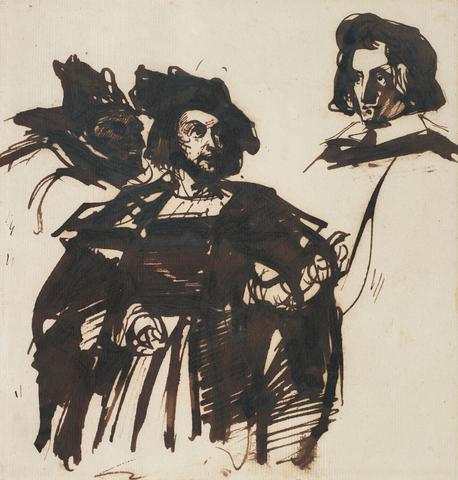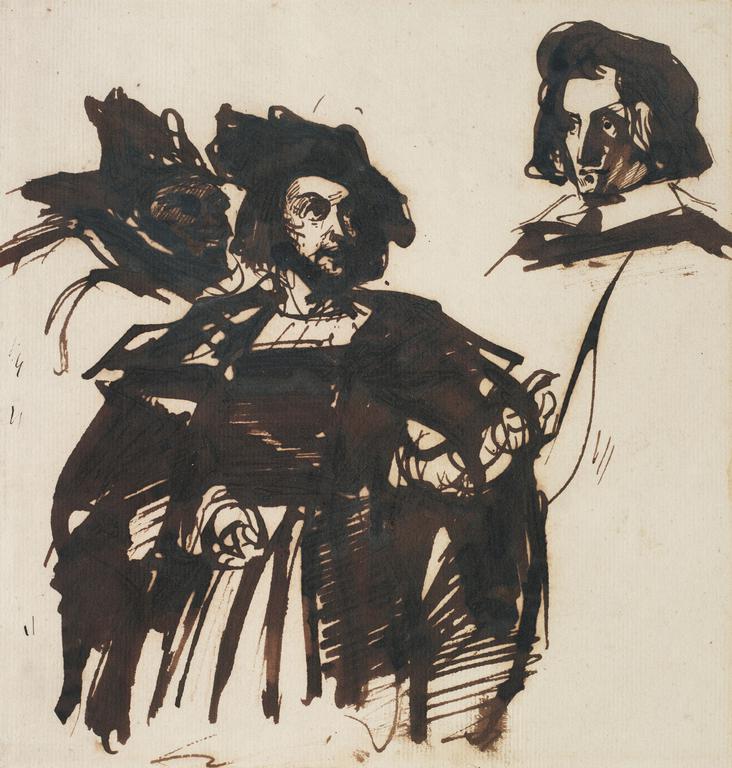
Étude pour Faust et Méphistophélès. Autoportrait de Delacroix (?)
Eugène Delacroix (1798 Charenton-Saint-Maurice - 1863 Paris)
1827
Plume et encre brune ; 17,1 x 16,4 cm
Provenance :
Don d’Eugène Delacroix à Victor Hugo (?) ; collection Auguste Vacquerie ; Paris, collection André Joubin ; Paris, Hôtel Drouot, 23 mars 2001 ; Paris, collection Ginette et Alain Lesieutre ; Paris, Sotheby's, 29 juin 2017 ; Paris, collection Le Polyptyque ; Paris, collection privée.
Exposition :
Eugène Delacroix (Zurich, Kunsthaus, 1939, n°143).
Bibliographie :
Auguste Vacquerie, Profils et grimaces, Paris, Michel Lévy Frères Éditeurs, 1856 (reproduit p. 136) ; André Joubin, Correspondance générale d’Eugène Delacroix, vol. I, Paris, Plon, 1936 (reproduit en frontispice) ; Pierre Georgel, « Delacroix et Auguste Vacquerie », dans Bulletin de la Société de l'Histoire de l'Art Français, 1970, p. 181 (Étude pour l’illustration de Goetz von Berlichingen (?)).
Bibliographie comparative : Arlette Sérullaz, « Un parcours initiatique. Delacroix illustrateur de Faust », dans Johann Wolfgang von Goethe, Faust illustré par Eugène Delacroix, traduction de Gérard de Nerval, Paris, Diane De Selliers, 2011.
Ce dessin lie trois génies du Romantisme : Goethe, auteur du premier Faust, illustré par Delacroix, jeune encore mais déjà célèbre (et controversé) après les Scènes des massacres de Scio (1824) et La Mort de Sardanapale (1827). Et s’il n’est pas certain que ce fût un don de Delacroix à Hugo, ni qu’il représente (en haut à droite) Hugo, en tout cas il appartint à l’un de ses fidèles, Auguste Vacquerie, et le suivit dans son exil à Jersey et Guernesey.
Delacroix rencontra Hugo en 1826, et dessinera les costumes d’Amy Robsart, pièce parue sous le nom du beau-frère de ce dernier, Paul Foucher, en 1828. Mais le peintre et l’écrivain ne s’appréciaient guère, même si Victor Hugo, dans une lettre à Victor Pavie (17 juillet 1828) parle du « Faust des deux grands poètes, Goethe et Delacroix ». C’est Paul Foucher qui servira d’intermédiaire lorsqu’en 1851 Auguste Vacquerie se porte acquéreur de trois tableaux de Delacroix (Le Lever, Le Bon Samaritain et Le Giaour). André Joubin a reproduit ce dessin, en frontispice de la Correspondance générale d’Eugène Delacroix, comme « offert par lui à Victor Hugo en 1828 », « avec en haut un portrait de Victor Hugo ». Mais qu’Auguste Vacquerie l’eut photographié à Jersey, en 1855, et reproduit dans son ouvrage Profils et grimaces, ne signifie pas qu’il appartenait à (et représentait) Victor Hugo. Pas plus ne semble-t-il représenter Eugène Delacroix lui-même, comme on l’a proposé ensuite.
Delacroix reçut commande de l’éditeur Charles Motte, en 1826, d’une série de lithographies pour Faust, dans la traduction d’Albert Stapfer, qui paraîtra en 1828 (la même année que celle de Gérard de Nerval, qui fera référence). Entre-temps, en 1827, avait été donnée la première représentation de la pièce, dans une adaptation d’Emmanuel Théaulon, au Théâtre des Nouveautés.
Le dessin serait donc soit préparatoire à la lithographie – mais l’iconographie ne correspond pas – soit consécutive aux représentations données au Théâtre des Nouveautés. De fait l’attitude de Faust, fièrement campé, celle de Méphisto, lui chuchotant à l’oreille, sont éminemment théâtrales, et le profil en haut à droite ressemble plus à Bouffé, qui jouait Méphisto, qu’à Hugo ou Delacroix. Ce dernier l’aurait croqué comme à la ville, incarnation de la jeunesse romantique, en même temps que sur scène, tout en noirceur diabolique.
Laissons le dernier mot à Goethe, dans ses Conversations avec Eckermann (29 novembre 1826). Il a reçu de Paris deux lithographies déjà réalisées par Delacroix : « je dois avouer – commente-t-il – que, dans ces scènes, M. Delacroix a surpassé ma propre vision. »
